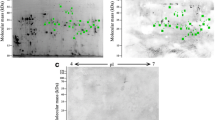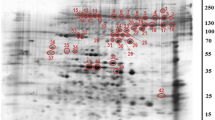Abstract
Hymenolepis diminuta is an important model species in studies of therapeutics, biochemical processes, immune responses and other aspects of cestodiasis. The parasite produces numerous excretory-secretory (E-S) proteins and a glycocalyx covering its body. Our study focused on the mass spectrometry analysis of the E-S material with an objective to determine if E-S contains any new proteins, in particular those that can be identified as: antigens, vaccine candidates and drug targets. These proteins might engage directly in host-parasite interactions. Adult parasites collected from experimentally infected rats were cultured in vitro for 5 and 18h. Immunoblotting was used to verify which E-S protein bands separated in SDS-PAGE (sodium dodecyl sulfatepolyacrylamide gel electrophoresis) react with specific antibodies from sera of infected rats. We identified thirty-nine proteins by LC-MS/MS (liquid chromatography mass spectrometry). Results indicated the presence of proteins that have never been identified in cestode E-S material. Immunoblotting showed the immunogenicity of E-S products of H. diminuta, most probably associated with the presence of proteins known as antigens in other flatworm species. Among identified proteins are those engaged in immunomodulatory processes (eg. HSP), in response to oxidative stress (peroxidasin) or metabolism (eg. GAPDH). The predominant functions are associated with metabolism and catalytic activity. This is the first study identifying E-S-proteins in adult tapeworms, thus providing information for better understanding host-parasite interrelationships, and may point out potential targets for vaccines or drug discovery studies, as among the proteins observed in our study are those known to be antigens.
Similar content being viewed by others
References
Arai H.P. 1980. Biology of the tapeworm Hymenolepis diminuta. 1st ed. New York: Academic Press INC
Asea A. 2008. Heat shock proteins and toll-like receptors. Handbook of Experimental Pharmacology, 183, 111–127
Aziz A., Zhang W., Li J., Loukas A., McManus D.P., Mulvenna J. 2011. Proteomic analysis of Echinococcus granulosus hydatid cyst fluid from sheep, cattle and humans. Journal of Proteomics, 74, 1560–1572. DOI: 10.1016/j.jprot.2011.02.021
Bártíková H., Vokřál I., Skálová L., Kubíček V., Firbasová J., Briestenský D., Lamka J., Szostakova B. 2012. The activity of drug-metabolizing enzymes and the biotransformation of selected anthelmintics in the model tapeworm Hymenolepis diminuta. Parasitology, 139, 809–818. DOI: 10.1017/S00311 82011002265
Bernal D., de la Rubia J.E., Carrasco-Abad A.M., Toledo R., Mas-Coma S., Marcilla A. 2004. Identification of enolase as plasminogen- binding protein in excretory-secretory products of Fasciola hepatica. FEBS Letters, 563, 203–206
Bien J., Näreaho A., Varmanen P., Gozdzik K., Moskwa B., Cabaj W., Nyman T.A., Savijoki K. 2012. Comparative analysis of excretory-secretory antigens of Trichinella spiralis and Trichinella britovi muscle larvae by two-dimensional difference gel electrophoresis and immunoblotting. Proteome Science, 10(1), 10. DOI: 10.1186/1477-5956-10-10
Čadková Z., Miholová D., Száková J., Válek P., Jankovská I., Langrová I. 2014. Is the tapeworm able to affect tissue Pb-concentrations in white rat? Parasitology, 141, 826–836. DOI: 10.1017/S0031182013002242
Charlier J., van der Voort M., Kenyon F., Skuce P., Vercruysse J. 2014. Chasing helminths and their economic impact on farmed ruminants. Trends in Parasitology, 30, 361–367. DOI: 10.1016/j.pt.2014.04.009
Chemale G., van Rossum A.J., Jefferies J.R., Barrett J., Brophy P.M., Ferreira H.B., Zaha A. 2003. Proteomic analysis of the larval stage of the parasite Echinococcus granulosus: causative agent of cystic hydatid disease. Proteomics, 3, 1633–1636
Cox F.E.G. 2002. History of Human Parasitology. Clinical Microbiology Reviews, 15, 595–612. DOI: 10.1128/CMR.15.4.595-612.2002
Cui S.J., Xu L.L., Zhang T., Xu M., Yao J., Fang C.Y., Feng Z., Yang P.Y., Hu W., Liu F. 2013. Proteomic characterization of larval and adult developmental stages in Echinococcus granulosus reveals novel insight into host-parasite interactions. Journal of Proteomics, 84, 158–175. DOI: 10.1016/j.jprot.2013.04.013
Curwen R.S., Ashton P.D., Johnston D.A., Wilson R.A. 2004. The Schistosoma mansoni proteome: a comparison across four life-cycle stages. Molecular and Biochemical Parasitology, 138, 57–66
Dea-Ayuela M.A., Sadkowska-Todys M., Wroblewski J., Torrado-Durán J.J., Golab, E., Bolas-Fernández, F. 2015. Immunoproteomic analysis of Trichinella spiralis larval crude antigens recognized by sera from patients with trichinellosis after treatment with albendazole. Tropical Biomedicine, 32, 613–624
De la Torre Escudero E., Manzano-Roman R., Valero L., Oleaga A., Perez-Sanchez R., Hermandez-Gonzales A., Siles-Lucas M. 2011. Comparative proteomic analysis of Fasciola hepatica juveniles and Schistosoma bovis schistosomula. Journal of Proteomics, 74, 1534–1544. DOI: 10.1016/j.jprot.2011.05.024
Elias D., Britton B., Kassu A., Akuffo H. 2007. Chronic helminth infections may negatively influence immunity against tuberculosis and other diseases of public health importance. Expert Review of Anti-infective Therapy, 5, 475–484. DOI: 10.1586/14787210.5.3.475
Evans W.S. 1980. The cultivation of Hymenolepis in vitro. In: Arai HP editor. Biology of the tapeworm Hymenolepis diminuta. 1st ed. New York, Academic Press INC, 425–448
Garcia L.S., Bruckner D.A. 1997. Diagnostic medical parasitology. 3rd ed. Washington DC, ASM Press
Graepel R., Leung G., Wang A., Villemaire M., Jirik F.R., Sharkey K.A., McDougall J.J., McKay D.M. 2013. Murine autoimmune arthritis is exaggerated by infection with the rat tapeworm, Hymenolepis diminuta. International Journal for Parasitology, 43, 593–601. DOI: 10.1016/j.ijpara.2013.02.006
Harnett W. 2014. Secretory products of helminth parasites as immunomodulators. Molecular and Biochemical Parasitology, 195, 130–136. DOI: 10.1016/j.molbiopara.2014.03.007
Hernandez J.L., Leung G., McKay D.M. 2013. Cestode regulation of inflammation and inflammatory diseases. International Journal for Parasitology, 43, 233–243. DOI: 10.1016/j.ijpara.2012.09.005
Hewitson J.P., Harcus Y., Murray J., Agtmaal M., Filbey K.J., Grainger J.R., et al. 2011. Proteomic analysis of secretory products from the model gastrointestinal nematode Heligmosomoides polygyrus reveals dominance of Venom Allergen- Like (VAL) proteins. Journal of Proteomics, 74, 1573–1594. DOI: 10.1016/j.jprot.2011.06.002
Jefferies J.R., Campbell A.M., van Rossum A.J., Barrett J., Brophy P.M. 2001. Proteomic analysis of Fasciola hepatica excretory- secretory products. Proteomics, 1, 1128–1132
Johnston M.J., MacDonald J.A., McKay D.M. 2009. Parasitic helminths: a pharmacopeia of anti-inflammatory molecules. Parasitology, 136, 125–147. DOI: 10.1017/S003118200800 5210
Johnston M.J., Wang A., Catarino M.E., Ball L., Phan V.C., MacDonald J.A., McKay D.M. 2010. Extracts of the rat tapeworm, Hymenolepis diminuta, suppress macrophage activation in vitro and alleviate chemically induced colitis in mice. Infection and Immunity, 78, 1364–1375. DOI: 10.1128/IAI.01349-08
Kim J.H., Kim Y.J., Sohn W.M., Bae Y.M., Hong S.T., Choi M.H. 2009. Differential protein expression in Spirometra erinacei according to its development in its final host. Parasitology Research, 105, 1549–1556. DOI: 10.1007/s00436-009-1585-8
Knudsen G.M., Medzihradszky K.F., Lim K.Ch., Hansell E., McKerrow J.H. 2005. Proteomic analysis of Schistosoma mansoni cercarial secretions. Molecular and Cellular Proteomics, 4, 1862–1875
Kouguchi H., Matsumoto J., Katoh Y., Suzuki T., Oku Y., Yagi K. 2010. Echinococcus multilocularis: Two-dimensional Western blotting method for the identification and expression analysis of immunogenic proteins in infected dogs. Experimental Parasitology, 124, 238–243. DOI: 10.1016/j.exppara.2009.09.016
Kosik-Bogacka D.I., Wojtkowiak-Giera A., Kolasa A., Baranowska- Bosiacka I., Lanocha N., Wandurska-Nowak E., Izabela G., Salamatin R., Jagodzinski P.P. 2014. Hymenolepis diminuta: analysis of the expression of Toll-like receptor genes and protein (TLR3 and TLR9) in the small and large intestines of rats. Experimental Parasitology, 145, 161–167. DOI: 10.1016/j.exppara.2014.07.009
Laschuk A., Monteneiro K.M., Vidal N.M., Pinto P.M., Duran R., Cervenanski C., Zaha A., Ferrera H.B. 2011. Proteomic survey of the cestode Mesocestoides corti during the first 24 hour of strobilar development. Parasitology Research, 108, 645–656. DOI: 10.1007/s00436-010-2109-2
Liu F., Cui S.J., Hu W., Feng Z., Wang Z.Q., Han Z.G. 2009. Excretory/ secretory proteome of the adult developmental stage of human blood fluke, Schistosoma japonicum. Molecular and Cellular Proteomics, 8, 1236–1251. DOI: 10.1074/mcp.M800538-MCP200
Ludolf F., Patrocinio P.R., Correa-Oliveira R., Gazzinelli A., Falcone F.H., Teixeira-Ferreira A., Perales J., Oliveira G.C., Silva- Pereira R.A. 2014. Serological screening of the Schistosoma mansoni adult worm proteome. PLoS Neglected Tropical Diseases, 8, e2745. DOI: 10.1371/journal.pntd.0002745
Mansur F., Luoga W., Buttle D.J., Duce I.R., Lowe A., Behnke J.M. 2015. The anthelmintic efficacy of natural plant cysteine proteinases against the rat tapeworm Hymenolepis diminuta in vivo. Journal of Helminthology, 12, 1–10. (Epub ahead of print) PubMed PMID: 25761568
Melon A., Wang A., Phan V., McKay D.M. 2010. Infection with Hymenolepis diminuta is more effective than daily corticosteroids in blocking chemically induced colitis in mice. Journal of Biomedicine and Biotechnology, 2010, 384523. DOI: 10.1155/2010/384523
Monteneiro K.M., de Carvalho M.O., Zaha A., Ferreira H.B. 2010. Proteomic analysis of the Echinococcuc granulosus metacestode during infection of its intermediate host. Proteomics. 10, 1985–1999. DOI: 10.1002/pmic.200900506
Morphew R.M., Barret J., Brophy P.M. 2006. In: Maule AG, Marks NJ editors. Parasitic flatworms molecular biology, biochemistry, immunology and physiology. Cambridge, MA: CABI International, 327–347
Nareaho A., Ravanko K., Holtta E., Sukura A. 2006. Comparative analysis of Trichinella spiralis and Trichinella nativa proteins by two-dimensional gel electrophoresis. Parasitology Research, 98, 349–354
Nguyen H.A., Bae Y.A., Lee E.G., Kim S.H., Diaz-Camacho S.P., Nawa Y, Kang I., Kong Y. 2010. A novel sigma-like glutathione transferaze of Taenia solium metacestode. International Journal for Parasitology, 40, 1097–1105. DOI: 10.1016/j.ijpara.2010.03.007
Pandey A., Mann M. 2000. Proteomics to study genes and genomes. Nature, 405(6788), 837–846
Perez-Sanchez R., Valero M.L., Ramajo-Hernandez A., Siles-Lucas M., Ramajo-Martin V., Oleaga A. 2008. A proteomic approach to the identification of tegumental proteins of male and female Schistosoma bovis worms. Molecular and Biochemical Parasitology, 161, 112–123. DOI: 10.1016/j.molbiopara.2008.06.011
Pockley A.G., Muthana M., Calderwood S.K. 2008. The dual immunoregulatory roles of stress proteins. Trends in Biochememical Sciences, 33, 71–79. DOI: 10.1016/j.tibs.2007.10.005
Ferreira A.G. 2011. Comprehensive proteomic profiling of adult Angiostrongylus costaricensis, a human parasitic nematode. Journal of Proteomics, 74, 1545–1155. DOI: 10.1016/j.jprot.2011.04.031
Reyes J.L., Wang A., Fernando M.R., Graepel R., Leung G., van Rooijen N., Sigvardosson M., McKay D.M. 2015. Splenic B cells from Hymenolepis diminuta-infected mice ameliorate colitis independent of T cells and via cooperation with macrophages. Journal of Immunology, 194, 364–378. DOI: 10.4049/jimmunol.1400738
Santivanez S.J., Hermandez-Gonzales A., Chile N., Oleaga A., Arana Y., Palma S., et al. 2010. Proteomic study of activated Taenia solium oncospheres. Molecular and Biochemical Parasitology, 171, 32–39. DOI: 10.1016/j.molbiopara.2010.01.004
Shi M., Wang A., Prescott D., Waterhouse C.C., Zhang S., McDougall J.J., Sharkey K.A., McKay D.M. 2011. Infection with an intestinal helminth parasite reduces Freund’s complete adjuvant- induced monoarthritis in mice. Arthritis and Rheumatism, 63, 434–444. DOI: 10.1002/art.30098
Shostak A.W. 2014. Hymenolepis diminuta infections in tenebrionid beetles as a model system for ecological interactions between helminth parasites and terrestrial intermediate hosts: a review and meta-analysis. Journal for Parasitology, 100, 46–58. DOI: 10.1645/13-347.1.
Sirover M.A. 1999. New insights into an old protein: the functional diversity of mammalian glyceraldehyde-3-phosphate dehydrogenase. Biochimica et Biophysica Acta, 1432, 159–184
Skrzycki M., Majewska M., Podsiad M., Czeczot H., Salamatin R., Twarowska J., Grynter-Zięcina B. 2011. Hymenolepis diminuta: experimental studies on the antioxidant system with short and long term infection periods in the rats. Experimental Parasitology, 129, 158–163. DOI: 10.1016/j.exppara.2011.06.014
Sotillo J., Valero L., Sanchez Del Pino M.M., Fried B., Esteban J.G., Marcilla A., Toledo R. 2008. Identification of antigenic proteins from Echinostoma caproni (Trematoda) recognized by mouse immunoglobulins M, A and G using an immunoproteomic approach. Parasite Immunology, 30, 271–9. DOI: 10.1111/j.1365-3024.2007.01019.x
Tsai I.J., Zarowiecki M., Holroyd N., Garciarrubio A., Sanchez-Flores A., Brooks K.L. et al. 2013. The genomes of four tapeworm species reveal adaptations to parasitism. Nature, 4, 496(7443), 57–63. DOI: 10.1038/nature12031
Virginio V.G., Monteneiro K.M., Drumond F., de Carvalho M.O., Vargas D.M., Zaha A., Ferreira H.B. 2012. Excretory/secretory products from in vitro-cultured Echinococcus granulosus protoscoleces. Molecular and Biochemical Parasitology, 183, 15–22. DOI: 10.1016/j.molbiopara.2012.01.001
Wang Y., Cheng Z., Lu X., Tang C. 2009. Echinococcus multilocularis: Proteomic analysis of the protoscoleces by two-dimensional electrophoresis and mass spectrometry. Experimental Parasitology, 123, 162–167. DOI: 10.1016/j.exppara.2009.06.014
Woolsey I.D., Fredensborg B.L., Jensen P.M., Kapel C.M., Meyling N.V. 2015. An insect-tapeworm model as a proxy for anthelminthic effects in the mammalian host. Parasitology Research, 114, 2777–80. DOI: 10.1007/s00436-015-4477-0
Yatsuda A.P., Krijgsveld J., Cornelissen A., Heck A.J.R., de Vries E. 2003. Comprehensive analysis of the secreted proteins of the parasite Haemonchus contorus reveals extensive sequence variation and differential immune recognition. Journal of Biological Chemistry, 278, 16941–16951
Author information
Authors and Affiliations
Corresponding author
Rights and permissions
About this article
Cite this article
Bień, J., Sałamatin, R., Sulima, A. et al. Mass spectrometry analysis of the excretory-secretory (E-S) products of the model cestode Hymenolepis diminuta reveals their immunogenic properties and the presence of new E-S proteins in cestodes. Acta Parasit. 61, 429–442 (2016). https://doi.org/10.1515/ap-2016-0058
Received:
Revised:
Accepted:
Published:
Issue Date:
DOI: https://doi.org/10.1515/ap-2016-0058




